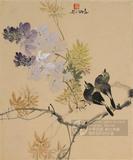清彭玉麐梅花 軸
推薦分享
資源連結
連結到原始資料 (您即將開啟新視窗離開本站)後設資料
- 資料識別:
- 贈畫000704N000000000
- 資料類型:
- 類型:繪畫
- 型式:靜態圖像
- 著作者:
- 彭玉麐
- 主題與關鍵字:
- 梅(白.紅.蠟梅)
- 出版者:
- 數位化執行單位:國立故宮博物院
- 格式:
- 本幅 108.9x31.7公分
- 關聯:
- 黃杰先生遺贈文物目錄,頁93、150&* 彭玉麐或書為彭玉麟(西元一八一六—一八九○年),祖籍湖南衡陽。字雪岑,號雪琴、退省庵主人。官至兵部尚書,諡剛直,能詩善書。 彭玉麐與其外祖母的養女梅姑,青梅竹馬,私許終身,但因輩分不合,無法結成連理,梅姑另嫁他人,後因難產而死。彭玉麐遂立誓畫梅萬幅,以紀念兩人之情。本幅為黃莉容、黃文如姐妹捐贈,畫梅用筆蒼勁有力,與畫幅中間作者款識的奇峭書法兩相輝映,饒富意趣。&*Peng Yulin’s ancestors came from Hengyang in Hunan. His style name was Xuecen, and sobriquets were Xueqin and Tuisheng’an zhuren. He served to the post of Minister of War and was posthumously entitled Gangzhi, being also gifted at poetry and calligraphy. Peng Yulin and Meigu, the adopted daughter of his maternal grandmother, had a strong affection for each other since childhood and were in love for all their lives. However, because of their positions in the clan, they could not become a couple. She eventually married someone else and would die in labor. Peng Yulin made a vow to do 10,000 paintings of plum blossoms to commemorate their affection. This work, donated to the National Palace Museum by the sisters Huang Lirong and Huang Wenru, depicts plum blossoms using mature and forceful brushwork, echoing perfectly the sharp calligraphy of the artist’s signature in the middle of the painting for an interesting effect.&*彭玉麐或書為彭玉麟(1816—1890),祖籍湖南衡陽。字雪岑,號雪琴、退省庵主人。官至兵部尚書,諡剛直,能詩善書。據說他與其外祖母的養女梅姑,青梅竹馬,私許終身,但因輩分不合,無法結成連理,梅姑另嫁他人,後因難產而死。彭玉麐遂立誓畫梅萬幅,以紀念兩人之情。 本幅畫梅用筆蒼勁有力,與畫幅中間作者款識的奇峭書法兩相輝映,饒富意趣。 黃杰先生舊藏,黃莉容、黃文如姐妹捐贈於民國85年。(20110204)&* The ancestors of Peng Yulin (style name Xuecen; sobriquets Xueqin and Tuisheng’an zhuren) came from Hengyang in Hunan. He served up to the post of Minister of War, received the posthumous name Gangzhi, and was also good at poetry and especially calligraphy. He reportedly since childhood had a strong affection for Meigu, the adopted daughter of his maternal grandmother. Though in love with each other throughout their lives, their positions in the clan meant that they could not become a couple. She eventually married someone else but died in labor. Peng Yulin thereupon made a vow to do 10,000 paintings of plum blossoms to commemorate their affection. This painting of plum blossoms uses mature and forceful brushwork, echoing the sharp calligraphy of the artist’s inscription and signature in the middle of the painting for a very interesting effect. From the former collection of Mr. Huang Chieh, this work was donated to the National Palace Museum by the sisters Huang Li-jung and Huang Wen-ju in 1996.(20110204)
- 管理權:
- 國立故宮博物院
授權聯絡窗口
- 國立故宮博物院圖像授權、出版授權、影音資料授權-申請流程說明
http://www.npm.gov.tw/zh-TW/Article.aspx?sNo=03003061






